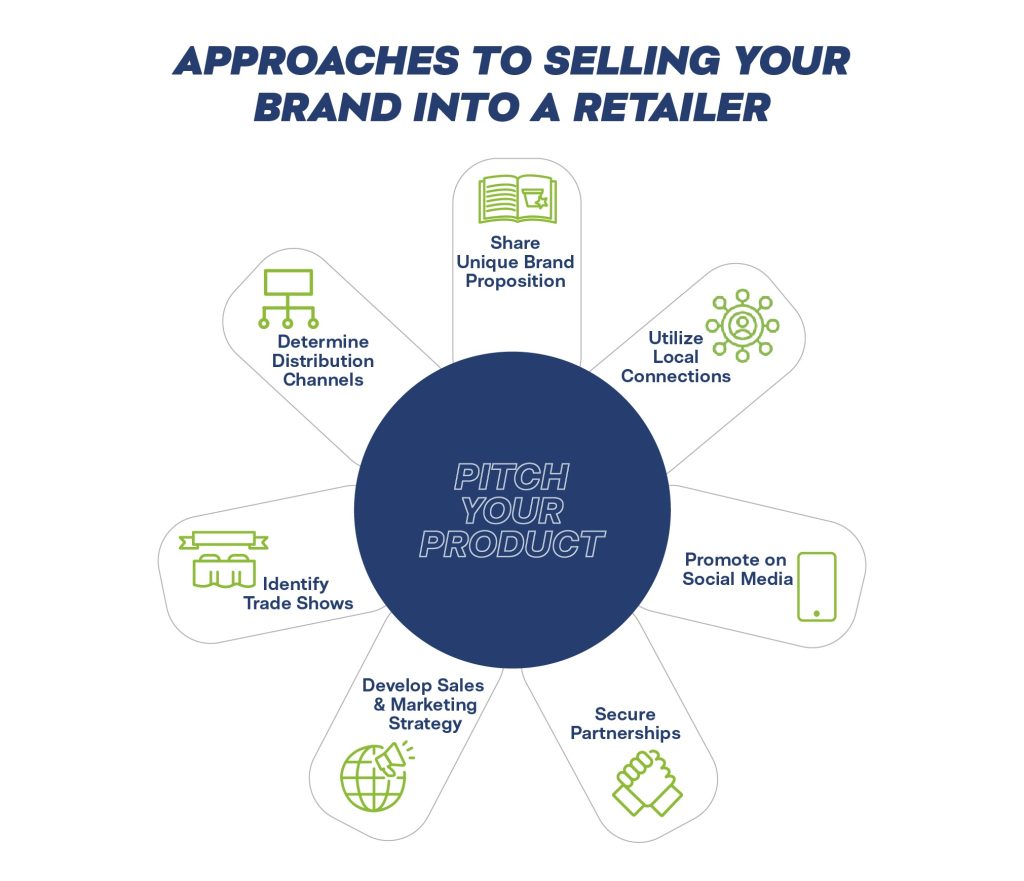Having shelf space at a store is a big step in your business venture. Imagine, you walk into a store and see people purchasing your products. From new customers to wholesale orders, your business can grow like never before. This experience can be new and exciting, but there are many steps to take in the process. It’s important to know your target market, have a strong sales and marketing strategy, and take time to prepare for a meeting to pitch your product.
Your Brand’s Unique Story
A unique selling proposition allows you to know your product better than anyone else. There are many things to consider when deciding if you want to place your brand in stores. Creating a selling point allows buyers to differentiate your product from the rest. You are selling your brand’s story; distributers want to see something new and different that’s not yet offered in a store.
Here are some questions to consider when thinking about what makes your brand unique:
- Do you work with specialty or organic materials?
- Is there a niche market you fulfill?
- Would you be able to offer a lower price compared to other brands?
- How does your product differ from top competitors?
- What about your product appeals to your target audience?
Knowing your brand well demonstrates trust and confidence in what your company has to offer. Utilizing story mapping is another great way to help with planning. Story mapping allows you to visually map a consumer experience. This gives an overview and a better understanding on how a customer may interact with your product to their final purchase.

Finding Distribution Channels
Selecting a distributor to fit your product is one of the first steps to getting your brand on a shelf at a retailer. Find out who distributes your competitor’s items or any that offer complementary products to your brand. It’s important to find a distributor who currently represents similar and popular brands to yours. This makes the process go smoother, as the distributor is already familiar with the market. Buyers can also ship complementary products together to reduce costs, which in return increases revenue.
Creating Local Connections
One of the best ways to get your foot in the door is to establish relationships with local buyers. Starting with local companies can help promote your product or service. In many towns, business owners have relationships with one another. When you establish relationships with locals, word gets around. Selling to local grocery stores or markets is a great way to begin getting your product on a shelf. Offering samples and handing out business cards helps make your brand memorable to buyers. Make sure to do your market research on which local opportunities would best fit your target audience.
Trade Show Opportunities
Trade shows are a great opportunity for emerging brands. Many retailers attend trade shows and are constantly looking for the next big, new product. This gives you a chance to reach a multitude of buyers in person. The results can be profitable for attending these shows and involves a lot of time and commitment. You must be certain your investments will have a high return when attending these types of events.
You have opportunities to create a booth or experience that stands out from others. You can use similar concepts from stores that catch people’s eye. Creating memorable moments when interacting with buyers shows how unique your brand is. Overall, these marketing efforts will pay off long term.
The Importance of Social Media
Today, everyone is online. Social media can be used to your advantage when promoting your product. Buyers want to see if you have a following or audience, which shows how well you can advertise or how popular your product is to consumers. Using niche influencers based on your market can develop buzz for you brand. Influencers have popularity and a large audience reach. Brands that strike deals with the right influencers can create engaging content to impact consumers’ buying decisions.
Interacting or commenting with similar accounts shows your online presence. This shows people you are well-versed in today’s world and active in utilizing social media accounts. Social media can be cheaper compared to other advertising, and a smart business decision when promoting your product.
Strategic Marketing Strategies
Your sales and marketing strategy is what is going to get people to buy your product. Distributors want to know how you will promote and sell to retailers because they want to make sure your products will generate revenue. Profitable items for retailers are ones that are constantly moving and being replenished. Knowing how to promote your product using marketing resources either by advertisements, trade shows, endorsements, or different sales campaigns will help make sure your product will sell.
The Power of Partnerships
Partnerships are one of the best ways to build brand awareness. Utilizing another company that complements your product can allow you to gain a larger presence. You will be able to reach a similar, substantial target market. Their audience will recognize your product and how it will benefit them when they purchase another. This is a great way to become familiar in the industry to become a brand with staying power.
Pitch Your Product
Pitching your product in person, rather than over the phone, increases your chances of getting your products in stores, rather than over the phone. By being in person, you can provide samples to give during your presentation to the buyers. It’s important to be considerate of the purchasing manager’s time, so make sure your presentation highlights important key points, yet is concise so that you don’t take up too much time. Include a sell sheet or document with all your products information such as data insights or key details about your brand. There are many factors to think about when perfecting you CPG presentation.
Utilizing Big Data and Analytics
When pitching your product, its best to provide different types of data and analytics to present to the buyer. Predictive analytics can show consumer’s purchasing habits, which is a great way to showcase the behavior of your target market. Providing sales data can show the growth of your product over time and how it compares to your competitor’s sales. Showcasing data from Google Analytics can provide your social media accounts, website traffic, or advertising reach, which tells buyers how well your marketing strategy is doing.
Having this information from different analytical tools can show key metrics that prove your product can succeed in a retailer. This gives validity to your brand, allowing the buyer to be sure your product can provide revenue. This will also show your product’s trajectory and the loyal consumer base you currently have.
Steps to Think About in Preparation
There are four things you should think about when you are preparing for your presentation. It’s important to be ready for any questions buyers may ask, and you want to be able to provide them the detailed information they need. By following these steps, you will know the best way to approach the retail buyers:
- Do your research – make sure the retailer will be interested in your product. If you have a specialty product, it’s important to find out if the retailers sell similar items. This way, you know your product can sell to their demographic as well.
- Perfect you pitch – create a brief, memorable statement to begin your presentation. This works to capture the buyer’s attention quickly so that you can then dive into how the retailer would benefit from your product.
- Bring data – Provide a document you can give to the buyers with all sales numbers and data that validates your product and pitch. Statistics that show the life and projection of your product can impress the buyer.
- Find the decision maker before the presentation – Linkedin is the perfect tool to research who the decision maker is for the retailer. You can even begin to build a relationship with them by connecting on Linkedin. They can see all your accomplishments through your profile, which in return can make you more favorable.
Try Approaches That Fit You and Your Brand
Not every approach can fit your business strategy or brand. Understand what works for you and your product or service, that way you can perfect your plan. Trying different approaches is the best way to get your product in a store. You’ll never know what will work best until you try it. Understanding how to approach a store is a valuable skill that will help your company succeed and develop in ways you never imagined.
Alliance Sales & Marketing is a future-forward broker serving brands across the country. We have a motivated, experienced team to get your product shelf space at a retailer. Contact us today to learn more.


